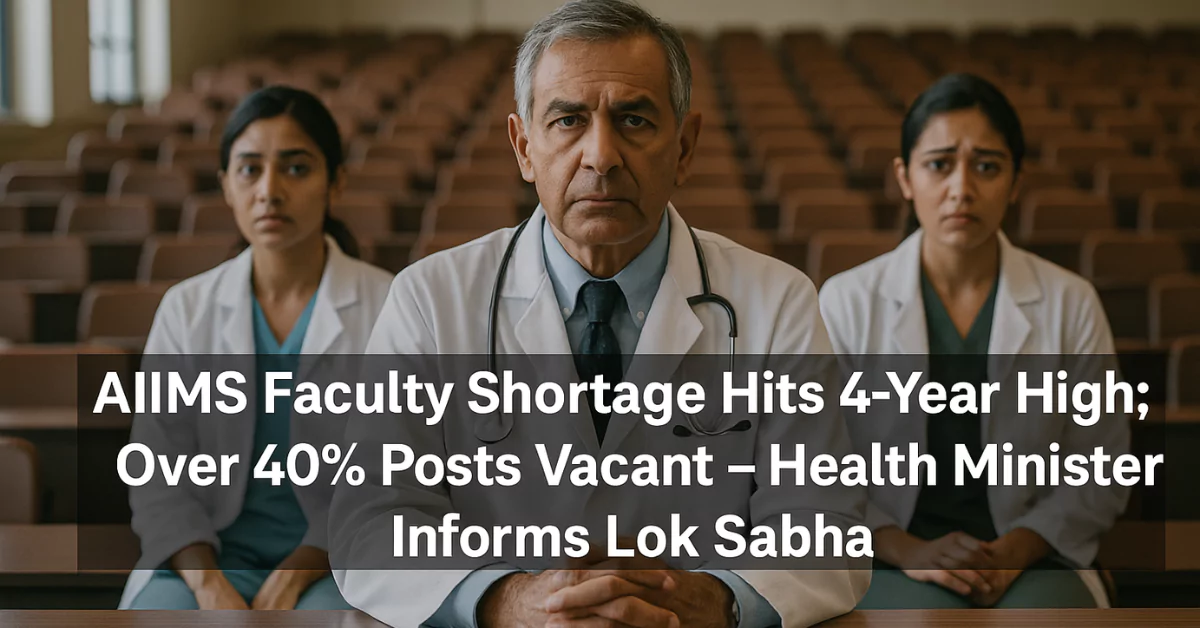New Delhi: India’s top public medical institutes, the All India Institutes of Medical Sciences (AIIMS), are struggling with a serious AIIMS faculty shortage crisis. In 2025-26, more than 40% of sanctioned faculty positions across 21 AIIMS remain vacant, the highest in four years.
This information was given in a written reply by MoS Health Ministry Prataprao Jadhav to Rajya Sabha MP Javed Ali Khan, highlighting the critical faculty crisis in these institutes of national importance.
Additionally, the minister said that staffing includes 72 contractual doctors serving as faculty and 8 retired officials engaged on contract, reflecting stop-gap arrangements to offset permanent staffing gaps.
AIIMS Faculty Shortage in Numbers
- Total sanctioned posts (2025-26): 6,376
- Vacant posts: 2,561
- Vacancy rate: 40.2% (same as last year)
- Highest vacancies since 2022-23 (when 2,099 posts were empty)
Six AIIMS, including the flagship campus in New Delhi, recorded their highest vacancies in four years:
- AIIMS Delhi: 462 vacant posts
- AIIMS Jodhpur: 186
- AIIMS Rishikesh: 147
- AIIMS Bhubaneswar: 103
- AIIMS Mangalagiri: 158
- AIIMS Gorakhpur: 98
Deep AIIMS Faculty Shortage Cisis at New AIIMS
Faculty strength at newer campuses remains alarmingly low:
- AIIMS Awantipora (J&K): 94 posts sanctioned since 2023-24, none filled
- AIIMS Madurai: 49 of 183 posts filled
- AIIMS Rajkot: 76 of 183 posts filled
- AIIMS Bilaspur: 126 of 217 posts filled
AIIMS Faculty Shortage Trend Over the Years
The shortage has worsened since 2022-23:
- 2022-23: 38.8% posts vacant (2,099 of 5,410)
- 2023-24: 40.2% vacant (2,346 of 5,836)
- 2024-25: Slight improvement to 37.6% vacant
- 2025-26: Back to 40.2% vacant
Vacancies increased at 10 AIIMS campuses, Delhi, Bhubaneswar, Jodhpur, Rishikesh, Mangalagiri, Nagpur, Kalyani, Gorakhpur, Bilaspur, and Deoghar.
Meanwhile, 10 others, including Bhopal, Raipur, Patna, Bathinda, and Guwahati, showed improvement.
Why Are Posts Staying Empty?
Experts blame low pay in government hospitals and better opportunities in the private sector.
Former AIIMS Bhopal Director Ajai Singh warned, “fewer teachers hurt the quality of medical education, especially practical training, which is crucial for producing skilled doctors.”
He stressed that many doctors prefer corporate hospitals because of higher salaries and better career prospects.
Government’s Action Plan
Minister Jadhav told Parliament that recruitment is a continuous process. Steps being taken include:
- Each AIIMS has a Standing Selection Committee to speed up hiring
- Retired faculty from top government institutions can be hired on contract till age 70
- Visiting faculty scheme introduced to bring in senior experts from India and abroad
| Permanent Recruitment Body: Each new AIIMS has a Standing Selection Committee (SSC) constituted to handle faculty recruitment on a rolling basis, ensuring vacancies are filled without long administrative delays. | |
| Composition: The SSC typically includes 1. The institute’s Director 2. Senior faculty members 3. Domain experts from other AIIMS or Institutes of National Importance 4. And a representative from the Ministry of Health & Family Welfare for transparency. | |
| Standing Selection Committee of AIIMS | Faster Hiring Process: Unlike ad-hoc recruitment panels, the SSC meets periodically throughout the year, allowing continuous processing of applications and quicker replacement of vacant posts. |
| Merit-Based Shortlisting: The committee follows uniform eligibility criteria (experience, qualifications, research output) across all AIIMS, reducing subjectivity and ensuring selection of highly qualified faculty. | |
| Flexibility to Engage Experts: If needed, SSCs can invite external subject experts, national or international, for interviews and evaluation, especially in super-specialty fields facing acute shortages. |
Current Status of AIIMS
Out of 23 announced AIIMS:
- 19 are fully functional
- 1 (Madurai) is partially functional
- 3 (Awantipora, Darbhanga, Rewari) are still under construction
Notably, AIIMS Darbhanga and AIIMS Rewari have no sanctioned faculty posts yet.
Institute-Wise Breakdown: Sanctioned vs Filled Faculty Posts
Here’s how the distribution looks across the institutions:
| AIIMS Location | Sanctioned | Filled |
|---|---|---|
| Bibinagar | 157 | 112 |
| Bhatinda | 193 | 118 |
| Bilaspur | 191 | 114 |
| Deoghar | 182 | 110 |
| Gorakhpur | 187 | 103 |
| Guwahati | 157 | 101 |
| Kalyani | 259 | 148 |
| Madurai | 157 | 50 |
| Mangalagiri | 233 | 135 |
| Nagpur | 347 | 219 |
| Raebareli | 175 | 104 |
| Rajkot | 179 | 76 |
| Vijaypur | 157 | 86 |
AIIMS, Madurai and AIIMS, Rajkot appear most underscored, filling less than one-third of their faculty positions.
Addressing Structural Challenges
This under staffing is symptomatic of wider systemic issues. In the Rajya Sabha earlier this week, the Health Ministry revealed central measures to streamline hiring, including:
- Constituting Standing Selection Committees in each AIIMS to fast-track recruitment
- Engaging retired faculty on contract (up to age 70) from Institutes of National Importance or government medical colleges
- Rolling out Visiting Faculty Schemes that allow domestic and international professors to contribute to teaching in new AIIMS
- Conducting common entrance and recruitment exams (like INI-CET) centrally via AIIMS Delhi to fill academic and non-academic roles across the network
Compared to other new AIIMS sites, AIIMS Bhubaneswar is also struggling: 103 of 337 sanctioned faculty positions, over 30% of seats, remain vacant, alongside nearly 25% of non-faculty positions.
While centralised recruitment efforts and strategic faculty engagement models are underway, existing staffing levels at the 13 surveyed AIIMS still fall significantly short of sanctioned strength.
These gaps, especially in Madurai and Rajkot, may reduce academic quality and patient care in these critical institutions. Sustained monitoring and fastpaced staffing are essential to ensure these premier medical institutes fulfill their goal and mandate.


